You run a small business and have a steady stream of income from a group of customers who are loyal and keep coming back to you. It wasn’t easy to get here, but now that you are, you wonder—what’s next? You want to grow and eventually hire additional help to run your sales team, but at the moment it’s just you and your sales partner.
Having a solid customer base to build off of is a great starting point. Recognize that 65% of a company’s business comes from existing customers.1 Focusing on these individuals who’ve already spent their time and money with you is a smart avenue to start expanding your customer base.
As you’ve likely already experienced, getting the first dollar from someone new is a much greater effort than getting additional dollars from someone who’s already purchased from you. You can thank trust for that one.
There are a number of ways you can increase your customer base without a radical investment of marketing dollars, especially when working with a smaller team. The idea is to work smarter, not harder, a concept we believe in as a business that specializes in enabling you and your customers to connect easier, yet with more sophisticated technology at less cost.
How is this all possible? Without the resources of a big company to back you, below are seven ways for how you can expand your customer base. These are highly focussed techniques that you can use immediately to start seeing your numbers grow:
- Find the reason your customers keep coming back—and capitalize on it
- Cater to your VIPs and attract more customers in the process
- Be reachable when a prospect picks up the phone (or sends you a message)
- Create moments to delight when it’s least expected
- Mobilize your customer advocates
- Level up your online presence
- Use AI to get to the point—quickly
Want to grow your customers using a more sales-centric way? Grab this free outbound sales playbook.
7 best ways to increase your customer base
1. There’s a reason your customers keep coming back. Find it and repeat it.
For loyal, repeat customers who keep coming back, see if you can isolate the reason(s) for their returns.
- Product or service feature: Are there particular features to your product or features that are seen as enticing by a common set of repeat customers? Identify these by sending out customer feedback surveys to determine first-hand what they are. Or, if you’re conducting A/B testing in your marketing, pay attention to what specifically attracts your target audience by reviewing your analytics.
- Customer service: Are you providing exceptional service because you’re available to customers when they need you, because you’re proactive in supporting them, or because customers can reach you in any way that’s convenient for them? Look through each of these areas where you support the needs of your customers and identify which you excel at.
- Customer experience: At what moments during your customer’s journey are you exceeding expectations or creating delightful moments for them? Is it during, before, or after the purchasing process? If you’ve developed a customer journey map, you can determine this by seeing which entry points of the customer journey are frictionless—these are the areas where you’re creating positive experiences that allow a customer to move forward with their purchases.
- Industry needs: Are there common things specific to your industry that customers look for when choosing who to buy from? For instance, because of the convenience of purchasing in-store versus online, the ability for free and easy online returns is a trend kick-started by Amazon that now many businesses have adopted. A quick online search for “(Name of your industry) consumer trends” will give you some insight as to what these are.
Getting to the core of your differentiating strengths is a necessary exercise if you want to start capitalizing on your positive differences from competitors. By identifying the unique reasons why your customers choose you above everyone else, you can replicate these offerings, services, and or experiences to expand on your customer base.
For instance, Dollar Shave Club is a subscription based service that delivers grooming products. You might’ve heard of them through their (very) successful—and just downright funny—ad:
Customers love them because they get the convenience of receiving something regularly in the mail that they would otherwise need to go out of their way to pick up. Better yet, what they receive is a completely customized set of products just for them. Recognizing that this personalization feature is a strong selling point of theirs, Dollar Shave Club has included a short, interactive quiz on their site to further help customers find what’s best for them even more quickly:
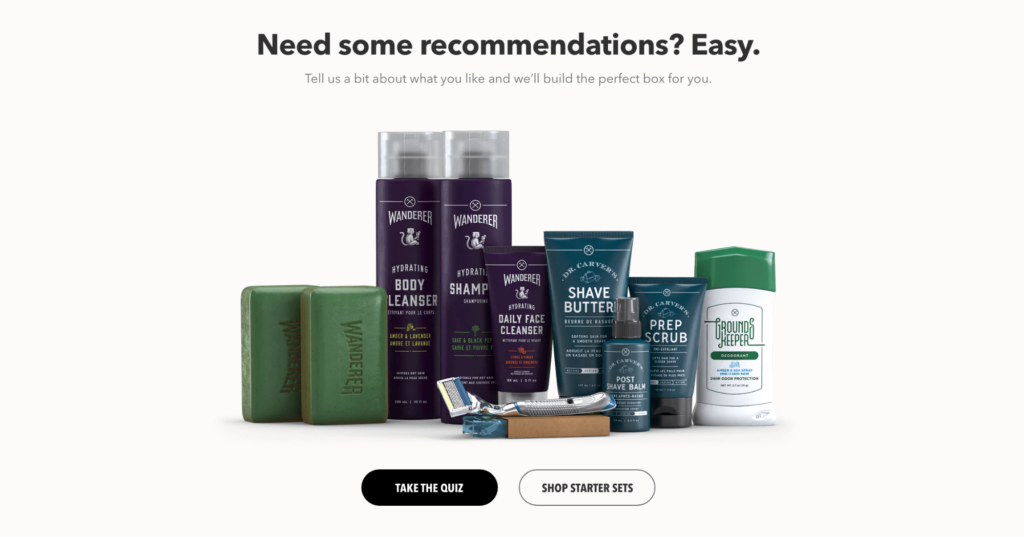
2. Cater to your VIPs and attract more customers in the process
Your VIP customers are those who bring in the most sales, and there’s a couple of ways to figure out who these individuals are:
- Marketing through social influencers? Dig into your social media analytics to see which influencers are driving the most traffic or sales towards you.
- Tracking your customers’ spend? If you’re using customer support software (as you should be), it’s easy to see which customers are making the largest or most frequent purchases from you. (If you’re tracking customer experience analytics, like customer lifetime value, by the way, this is a good metric to pay attention to here.)
- Have a referral system in place? Whether you set up a referral system or code or are just getting organic referrals from existing people, discover which customers are the ones who are often bringing in new leads.
- Getting reviews online? Even if your site doesn’t showcase reviews, it doesn’t mean your customers aren’t talking about you elsewhere. Check out your dedicated Google Business page, or simply do a search for “(Your business name) customer reviews” to see what people are saying about you. Specifically, check out who’s leaving you raving reviews and garnering attention from others through it. These people are your brand advocates who you don’t want to forget about!
After identifying who’s part of this VIP group of customers, introduce a customer segmentation strategy. That’s just another way of saying, be sure to section this group off and treat them uniquely, separate from the rest of your customers.
With this segmentation in place, provide incentives and offers to let them know just how important they are to your business with:
- Perks (free returns/shipping, gifts on their birthday, priority access)
- Discounts (exclusive sales or promotions, more chances to save)
- Exclusive events (virtual or in-person educational or entertainment sessions, such as a tasting event for wine drinkers)
To take it a step further, make these VIP incentives known so that other customers are motivated to gain a spot into this exclusive circle. Promote them on your website and social media platforms and let prospects see what benefits are in it for them if they grow their purchases with you.
Run Everything Labs, a nutrition supply store, incentivizes customers to earn back as much as they spend using a tiered VIP rewards program. If you can make it crystal clear what the benefits are, your already-loyal customers will be more motivated to move up into elite levels to receive even more savings and points to redeem for rewards:

3. Be reachable when a prospect picks up the phone (or sends you a message)
Did you know that 9 out of 10 text messages are read within three minutes of being received?2 That kind of speed and effectiveness should be a part of your sales strategy if you’re looking to directly reach prospect where their attention spans are. Emails and phone calls can feel distant, but texts are personal yet casual.
It’s a great tool for building and nurturing relationships with new and existing customers. Here’s what you should consider when getting started with setting up text support for the first time:
Choose a good communication tool: The right communications tool, like RingCentral Digital Engage™, will include SMS alongside a host of other channels like Facebook, Whatsapp, and Twitter so that you have an easy way to respond to prospects, no matter how they choose to reach you. Because it’s a cloud-based communications system, you never have to worry about physical assets depreciating or damaging over time:
Integrate with your CRM: There are tremendous ways you can increase productivity by having your communication tool integrate with customer service apps you’re already using, like your CRM (like Zoho, Zendesk, Oracle, amoCRM). For instance, you can manage incoming prospects’ calls and messages while seeing a full history of their previous interactions with your business:
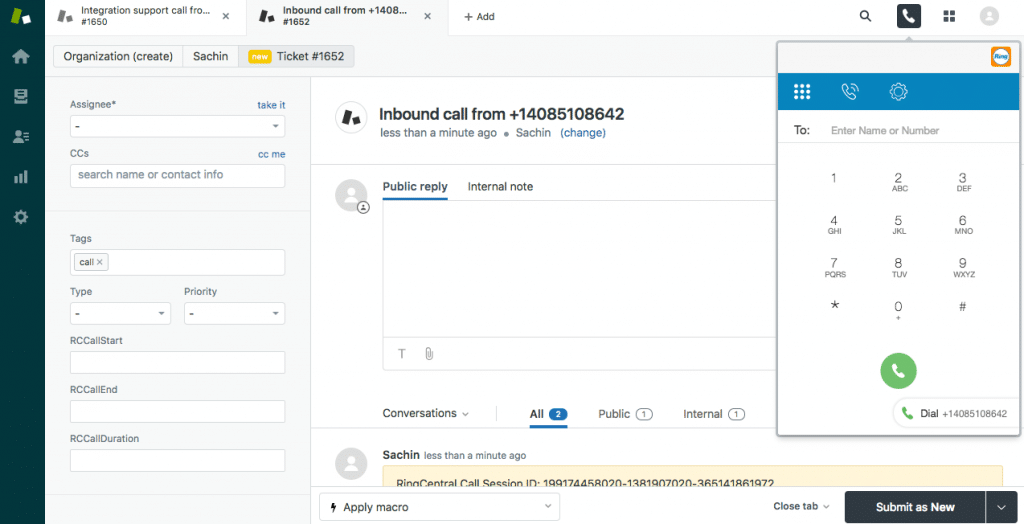
This way, your customers receive personalized support based on their personal experiences with you. You can also segment your customer base by their values to determine the urgency with which you should prioritize their requests.
Have an SMS strategy: In addition to using SMS as a prospect and customer support tool, you can use it as part of your sales strategy by setting up personalized follow-up sequences based on triggers in the pipeline stage. For instance, you can create an automated message to send when a customer’s activity with you begins to drop off and further pique their interest with a special discount:
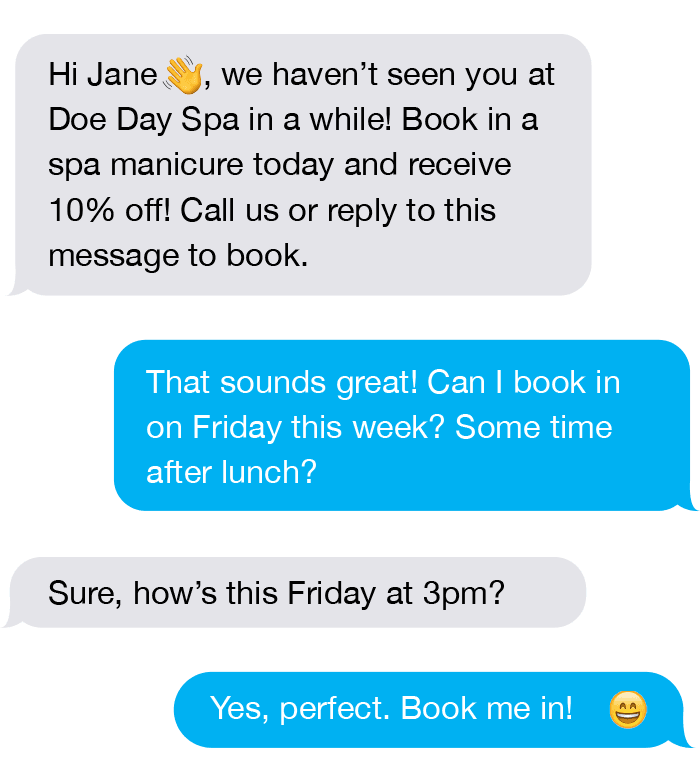
4. Create moments to delight when it’s least expected
Attract new prospects… check.
Engage and convert into customers… check.
Delight customers with positive experiences… wait, what’s this?
In the first two stages, attract and engage, you’re understanding prospects’ needs and meeting their expectations. That last step, delight, is how you exceed those expectations to create memorable experiences. Consider these three techniques:
- Anticipate their future problems and solve them: As a business, your first goal may be to provide an immediate fix to your prospects’ problems via your product or service. While this is an obvious win for you, for the customer, this may be just a short-term fix to a long-term issue. For instance, Patagonia offers an awesome “Ironclad Guarantee” that promises to repair, replace, or refund your purchase if you’re not completely satisfied. They foresee your concerns and provide a fix for it upfront.
- Help them to succeed: This is a little different than solving their problems directly. Here, you’re helping someone succeed by going above and beyond the point of purchase to offer support on how the customer can manage on their own. For instance, you can do things such as include a relevant resource article on “5 tips to stay safe outdoors” within the purchase confirmation email for a camping tent.
- Personalize their experience: No two customers are the same—nor would they want to be treated that way with a one-size-fits-all approach. Customize how you communicate with your prospects based on their characteristics and behaviors by personalizing your interactions with them. You likely already have a collection of information on your prospects stored in a CRM like Salesforce; to go a step further, integrate it with a dynamic communications tool like RingCentral to deliver hyper-customized interactions based on the prospects’ history with you. For instance, using functions like click-to-dial and call analytics, you can save time browsing for contact information and trust that your call records are logged reliably every time.
Delighting prospects is all about getting to know their interests and wishes then being able to meet and surpass those in a way that creates a remarkable experience. Showing support for your customers’ well-being proves you are interested in them beyond what they can do for you. The result: a satisfied customer who leaves happy—and feels inclined to promote your brand to others.
Jet City Device Repair, an electronics repair service, did exactly that when they learned that their customer’s problem was out of their hands. Instead of turning them away, they provided recommendations to help them succeed, even if it meant sending them away—and their not-customer sang their praises online for it:
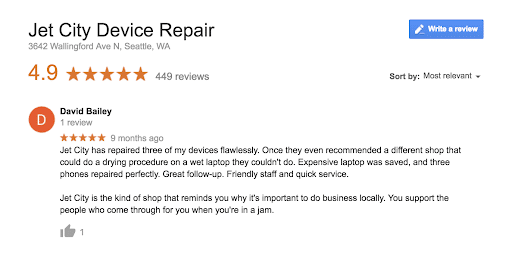
5. Mobilize your customer advocates
A successful method of establishing credibility is to build up social proof, referrals, and testimonials. Because 9 out of 10 customers trust online reviews as much as they do personal recommendations3, having your online presence be positively recognized by the public brings an undeniable advantage.
Every business has customers who are advocates of their brand. These are typically the people who love what you do and directly refer you to new leads or pass on recommendations for others to check you out. But keep in mind that not every advocate is as proactive as this. Some, while they would be happy to speak on your behalf, simply don’t remember to or don’t know how to do it.
A little encouragement and push on your end can help move these individuals along to share their feedback on you with others. In practice, here’s what it looks like:
- Find the right customers to ask for reviews: You want to request reviews from happy customers who are more likely to leave positive ratings. You can monitor your social media channels for those talking about your business favorably. Or, you can make these requests at the end of the successful delivery of your services.
- Make it super simple for the customer: The customer is going out of their way to support you, so make sure to keep your request short and sweet. Asking them to share a review in as few steps as possible increases the likelihood that they’ll actually do it. One way to do this is to add a Google review link directly into an email template to reduce the extra work they’d have to do.
- Automate the ask: If your business provides a service, you may find it makes sense to ask customers to leave a review at the end of your work with them. With these repetitive requests, automating the ask by, for example, putting a customer survey link in your receipt email, makes sure you never miss an opportunity. To do this, you can integrate your CRM with your email marketing tool so that the email template can be set to shoot off automatically depending on what stage of the process your customer is in.
Here’s an example of a short but effective email template that provides an incentive for a request for review and has the selections embedded directly into the email so that the customer doesn’t need to leave the page they’re on (who doesn’t love a low-effort task?):
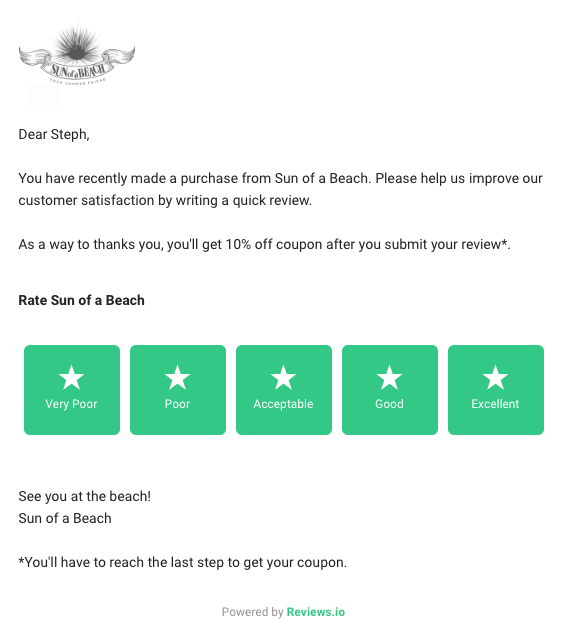
6. Level up your online presence
Okay. You’ve tapped into your VIPs and your advocates are starting to spread the word about you—you notice that traffic on your site is picking up. People are checking out your product page and deciding whether you’re somebody they want to buy from. Don’t skimp over your opportunity here to establish credibility. Here are a couple of areas in which you can build trust:
Build a content strategy: Your website should clearly address the benefits and problems that your product or services solve for the customer. Optimize every page by including relevant keywords in your content so that your site comes up first when customers do a search for related topics online.
Marketing content should also live on your social channels. Link your accounts to a digital engagement platform so that you can reach all your customers from different platforms at once. Plus, you’ll only need one place to check what customers are saying about it on social.
Be mobile-friendly: Have your site be adaptive for mobile displays so that the experience of someone browsing your site on desktop or mobile is equally smooth. Consider how the layout shifts and adapts as well as how people respond to making touchscreen selections when accessing on a smaller screen. For website templates that have built-in mobile adaptability, you can check out Shopify or Squarespace to get started easily. If you’re looking for a more custom build but have limited technical proficiency, then Webflow is a good option as well.
Ensure web accessibility: Not everyone has the same abilities when browsing the web. Those who are limited in their sound and sight might rely on audio or visual tools when interacting online. Set up your site to be compatible with these programs to increase usability for a diverse audience. Check out the most recent web accessibility standards to help you create the same experience for anyone who browses your page.
Make online ordering effortless: Design your e-commerce checkout flow with purpose. Make it obvious how customers can add/save items to their cart, remove distractions between shopping and checkout, provide adequate payment options, ensure the payment form looks secure, and send confirmation emails with your contact clearly listed promptly after checkout. As a bonus, you can recover abandoned carts with automated email marketing (using Mailchimp, for example) to entice a visitor who’s spent time on your site but hasn’t converted into a customer yet to return:
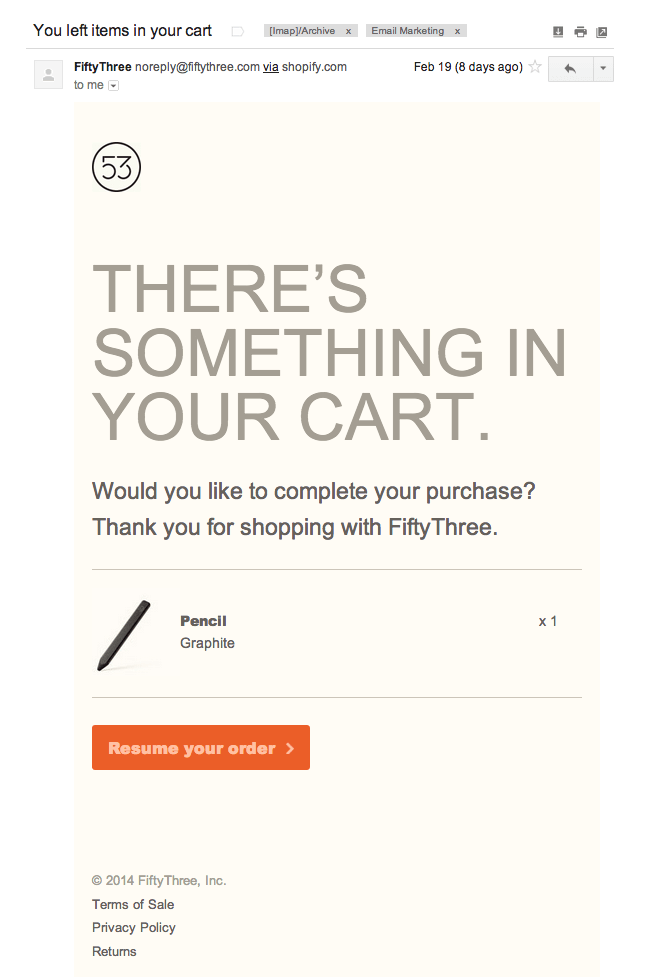
7. Use AI to get to the point—quickly.
Online reviews are picking up, and you’ve got some new leads from referrals—amazing! Now it’s all about being able to close on new sales. However, during a customer interaction, you find it challenging to hone in on solving what the customer’s specific needs are. Because they don’t exactly know what questions they should be asking, it’s hard for you to provide the support and experience they need.
Artificial intelligence and machine learning is one solution on how to remedy this challenge. Because of the precision of these technologies to surface roadblocks quicker, it no longer takes several phone calls or back-and-forth emails to get to the heart of what needs to be said.
Using XSELL for RingCentral during a customer conversation, you can see notes with guidelines for you to stay engaged and better predict your customer’s needs in real time on the screen display. It eases the experience for you, and in turn, simplifies the lives of your customers as well. The result is a better customer experience—that leads to improved conversion rates.
While many interactions often require speaking with a real person, some routine transactions or simple requests can be handled by AI alone. Fluctuating between these two types of communication can be done pretty easily using tools like LivePerson. It lets you handle multiple interactions at once by tapping into the power of AI to immediately handle simple transactions so that you can focus on more complex or meaningful tasks:
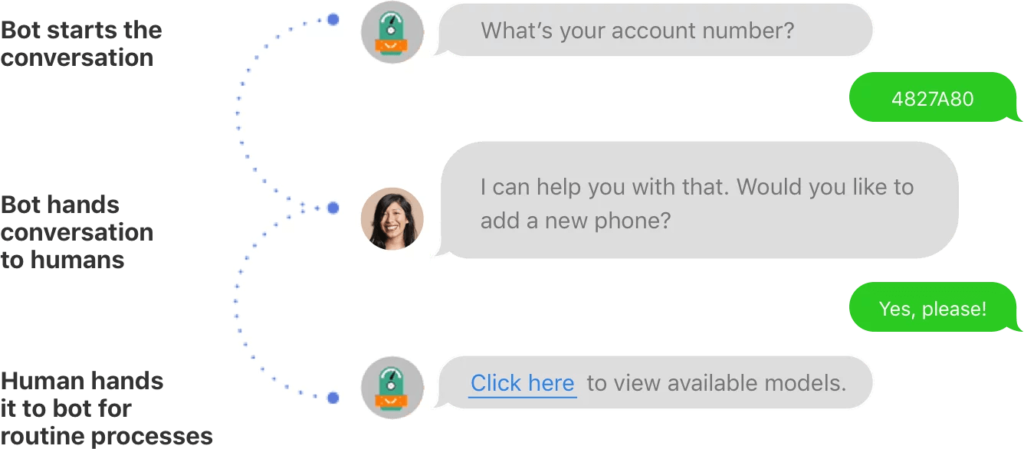
Grow your customer base by providing more customer value
Having a steady base of customers is beneficial when looking to expand on the number of customers you want to have.
With communication records, transaction logs, and purchasing habits known, you can use these to your advantage to uncover what unique values you’re bringing to your existing customers, which you can then optimize on to further bring in new customers.
1 smallbiztrends.com/2016/10/customer-retention-statistics.html
2 horisen.com/en/blog/10-reasons-why-you-should-use-sms-to-communicate-with-customers
3 blog.hubspot.com/service/customer-base
Originally published Jul 01, 2020, updated Oct 03, 2021





